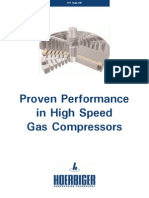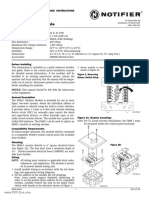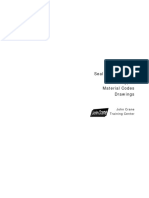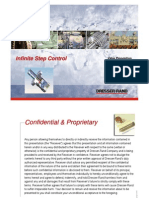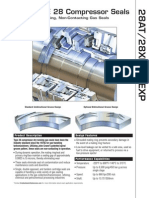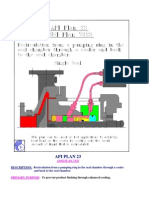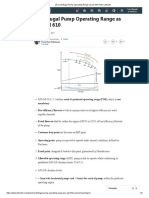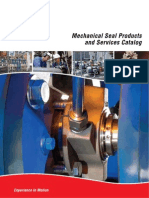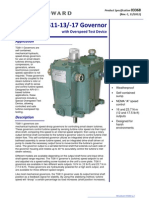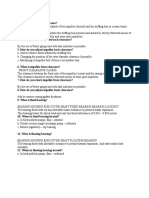Hoer Howandwhyvalvesfail
Hoer Howandwhyvalvesfail
Uploaded by
pathakshashankCopyright:
Available Formats
Hoer Howandwhyvalvesfail
Hoer Howandwhyvalvesfail
Uploaded by
pathakshashankCopyright
Available Formats
Share this document
Did you find this document useful?
Is this content inappropriate?
Copyright:
Available Formats
Hoer Howandwhyvalvesfail
Hoer Howandwhyvalvesfail
Uploaded by
pathakshashankCopyright:
Available Formats
COMPRESSOR VALVES
How and Why Compressor Valves Fail
What causes valves to fail or operate inefficiently?
Compressor valves significantly affect operating performance, efficiency and the life of reciprocating compressors. Valves open and close with every stroke of the piston. For a 1700 rpm machine, this means about 900 million cycles a year! Its remarkable, not that we have valve problems, but that we have as few as we do. When the valve malfunctions the compressor must be brought down for repair. Whatever improves or prolongs valve life will also improve machine availability and profitability.
Compressor valves fail for a variety of reasons. Causes of failures fall into two broad categories; those caused by environmental effects or abnormal mechanical action. The environment in which a valve operates may contain: corrosive elements foreign particles liquid entrainment and carryover improper lubrication formation of carbon or other deposits temperature extremes Valves are also subjected to destructive forces that lead to abnormal mechanical action. Tensile and compressive forces, impacts, twisting, bending, abrasion, and erosion can cause the valve to: flutter slam from delayed closings or other pulsations have multiple impacts from excess pulsations close late due to very low volumetric efficiency To determine the root cause of valve failure, our valve service professionals conduct a valve failure analysis. They investigate the physical evidencedeposits, wear, fatigue, and fractures. They work closely with customers obtain complete operational and valve design data to determine whether the failure is due to an inherent operating or maintenance practice or if the valve was poorly selected or manufactured. Compression efficiency is closely related to valve performance. A valves efficiency is analyzed over its entire life cycle. Valve studies provide anticipated pressure drops across the valve, and valve losses, for a specific application. The theoretical values obtained from a valve study are used to compare actual operating conditions to determine whether the valve is delivering optimum performance. Valve efficiency and valve lift are trade-offs. If valve lift is reduced to rectify a mechanical failure, the free lift area is also reduced, gas velocity through the valve increases, and more power is consumed. Lower lift and the resultant decrease in impact forces will extend the life cycle of a valve, but at the price of increased operating losses through lower efficiency.
the valve with the date of the failure, the compressor location and valve type and the operating hours . Then, describe what failed and any reason you suspect for the failure. Examine the maintenance history and compare it to other identical valves operating in the same gas stream. Often a pattern emerges suggesting proper corrective action. It is important to determine the root cause for mechanical or efficiency failure before a cure is sought. Determining root cause Solid knowledge of how a valve works is required for a proper diagnosis. Which components move or compress in the opening/closing cycles of a given design? Where must the valve seal when closed? Which surfaces are subject to friction or impact? Careful examination of a worn or broken valve will often disclose the reasons for premature breakage. Inspect the valve Carry out inspection in a well-lighted work area. Use an assembly vise to carefully dismantle the valve. Take care to keep the parts of each valve together and do not wipe or clean the component parts before the visual inspection or you may erase valuable clues. Try to relate wear of the valve to its hours of operation. Compressor valves are expected to operate from one turnaround to the next which may mean as long as a year. But in highly contaminated environments, even 2000 hours of uninterrupted performance may be acceptable. Examine maintenance records Maintain records about the frequency and nature of valve failures. Tag Develop a diagnosis The process of determining the root cause of the failure starts with eliminating poor assembly, poor machining, and manufacturing defects. Improper assembly. Was the failure due to improper assembly?Did the components meet manufacturer specifications, assuring that the valve could function properly at an acceptable life and efficiency level? Quality of repairs. Is the valve performing below par due to frequent repair? improper re-machining? wrong reassembly? Was reassembly performed with poor quality parts? Repairing a valve to rebuild specifications requires adherence to manufacturers specifications and should be carried out by the manufacturer or an authorized repair facility. Improper re-machining of a seat face...failure to remove burrs after rework...installation of the wrong coil or leaf spring elements...incorrect depth of pockets in the guards, etc. can all affect valve life adversely. Coil springs are an important component of a valve. They control valve timing. Springs should not be tampered with, or replaced with inferior quality products. Corrosion. If the gas has a substantial amount of corrosive contaminants, look for evidence of stress corrosion like damage to the sealing element (valve ring, plate and
springs). Certain compounds become corrosive only if moisture is present in the system, or develops after shutdown. This moisture, in combination with gas contaminants, can corrode valves. A gas sample should reveal whether any of these factors are at work. Hydrogen can cause embrittlement due to molecular penetration of the metal. To cope with corrosion, upgrade valve plate, ring or spring materials or in severe casesthe material of all valve components. Consult NACE specifications as a guide to material selection. Foreign material and impurities. Despite proper scrubbing, foreign matter occasionally wedges in the valve and prevents proper operation and ultimately causes damage. Examine the seat lands and impact surfaces of the valve plate for traces of foreign material. Minor indentations and imprints of the particles may show up between the valve plate and seat, too. Make certain separators, knockout pots and drains are working properly and are sized to handle impurities from upstream. Liquid carry-over. Liquid slugs are devastating to valves. The plate is subjected to extremely destructive forces and will crack. Slugs occur when entrainments get carried through and are formed when saturated gas contacts the cylinder wall. To prevent liquid carry-over, raise the cooling water temperature 10 or 15 degrees above the incoming gas temperature, as the water enters the cylinder jackets. If liquids are coming from the upstream feed line, check separators to eliminate those liquids. Improper Lubrication. Excessive
lubrication shortens valve life particularly suction valve life. When valve plates stick, closing is delayed and excessive force slams the valve shut. Excess lubrication resembles liquid carry-over and causes the same slugs as water contamination. Too much lubrication of the discharge valve results in coking, especially if the valve is exposed to higher temperatures. Mineral oils (especially with high ash content) will coke up more readily than synthetic oils. Abnormal mechanical action. Welldesigned valves, with the proper spring load for the application will open and close with no harmful pulsations. However, many valves are standardized for an average range of conditions and when applied outside this range may malfunction. Spring load. The correct spring load for a valve depends, among other factors, on its operating pressure, the gas velocity, and the specific gravity of the gas. If substantial changes from original design parameters are made, contact the manu-
facturer and have the valve springs re-engineered. Analyze the surfaces where the sealing elements impact against the seat or guard. If the surfaces have a hammered finish it indicates wear related to multiple impacts. Pressure pulsations. The fluctuating line pressure caused by pressure pulsations can result in multiple valve opening and closing during a single cycle. The flow of gas to and from the valve is channeled around cages, through cylinder openings and cavities under and above the valve. The uneven distribution of gas flow can cause plate valves to wobble during the opening and closing motion. Multi-ring valves may open unsynchronized; one ring opens first taking the most severe impact and others open later with lighter impact. One ring fractures more frequently than the others. Taking corrective action Computer simulation of valve opening and closing provides a rough indication of damage potential in a given application. When lab tests are insufficient, a thorough examination can be made while the valve operates in the compressor cylinder.
Performance analyzers, vibration detectors and ultrasonic leakage detectors provide an in-the-field diagnosis. Preventive maintenance programs will minimize equipment failures and unscheduled downtime. You can minimize the affects of environmental problems by using proper separators to provide pure, dry gas to the compressor. In corrosive environments, select valve material that is specially designed for the gas composition of the application. Lubrication should be applied according to manufacturers recommendations. Inspect the machine regularly while it is operating. During shutdowns, perform detailed maintenance inspections of systems and parts. Schedule personnel and materials appropriately. Keep good maintenance records. Bringing a compressor down is expensivenot only in downtime, but, more significantly in lost production. A good preventive maintenance program, based on realistic life cycles, will result in minimum losses in production and maximum maintenance efficiency.
HOERBIGER CORPORATION OF AMERICA, INC. ISO 9001 Registered 3350 Gateway Drive Pompano Beach, FL 33069-4841 Tel: (954) 974-5700 Fax (954) 974-0964 E-mail: mail@hoerbigercorp.com Web Site: www.hoerbiger-compression.com Regional Service Headquarters - HOERBIGER SERVICE, INC., and HOERBIGER (Canada), Ltd. Houston, Texas Tel: (281) 442-2497 Fax: (281) 442-5926 E-mail: hgcrho@hoerbigercorp.com New Castle, Delaware Tel: (661) 257-2888 Fax: (302) 322-5680 E-mail: hnernc@hoerbigercorp.com Oklahoma City, Oklahoma Tel: (405) 681-3100 Fax: (405) 681-6519 E-mail: hmcroc@hoerbigercorp.com Santa Clarita, California Tel: (302) 322-5090 Fax: (661) 257-1823 E-mail: hwnrsc@hoerbigercorp.com Mississauga, Ontario Tel: (905) 568-3013 Fax: (905) 568-2407 E-mail: hcl@hoerbigercorp.com Grande Prairie, Alberta Tel: (780) 532-1367 Fax: (780) 539-4931 E-mail: hclgp@hoerbigercorp.com
HAE2018/FP 5M 03/04
You might also like
- Iom Manual Sce en PDFDocument82 pagesIom Manual Sce en PDFcool47guy09100% (2)
- API 682 4th Edition Category 1 Configurations: 3CW-FBDocument19 pagesAPI 682 4th Edition Category 1 Configurations: 3CW-FBtuliofilipeNo ratings yet
- Volumetric Efficiency of CompressorDocument3 pagesVolumetric Efficiency of CompressorPeshala Gamage100% (2)
- Installation & Troubleshooting Guidelines For API Seal Flush PlansDocument132 pagesInstallation & Troubleshooting Guidelines For API Seal Flush PlansP_I_P_HNo ratings yet
- Hoer CT Valve 2Document5 pagesHoer CT Valve 2Tu PhamNo ratings yet
- SVS.4054.1014 Compressor Seal Replacement and UpgradesDocument8 pagesSVS.4054.1014 Compressor Seal Replacement and UpgradeslubangjarumNo ratings yet
- Explosive DecompressionDocument11 pagesExplosive DecompressionAndrey EkkertNo ratings yet
- Reciprocating Compressors IMPDocument21 pagesReciprocating Compressors IMPrutujaNo ratings yet
- Notifier FMM 1 Monitor ModuleDocument2 pagesNotifier FMM 1 Monitor Modulejames alfarasNo ratings yet
- NIKKISO PUMP Internal - Process - Flow - HN-TypeDocument5 pagesNIKKISO PUMP Internal - Process - Flow - HN-TypeTarek FawzyNo ratings yet
- Compressor Brochure A4 - SpreadsDocument27 pagesCompressor Brochure A4 - SpreadsIwan Abdurahman100% (1)
- Идентификация Jc Типы, Материалы, ЧертежиDocument92 pagesИдентификация Jc Типы, Материалы, ЧертежиTallan LemNo ratings yet
- ISC HydroCom ComparisonDocument22 pagesISC HydroCom Comparisonrahilshah100No ratings yet
- Recip. Comp ECDPDocument51 pagesRecip. Comp ECDPSkydriver Paul100% (1)
- CCO New Moppet A4 Sales Sheet 100418Document2 pagesCCO New Moppet A4 Sales Sheet 100418Puja Ningrat WibowoNo ratings yet
- Mechanical Seal and Support System Considerations For Negative Temperature Hydrocarbon Services: NGL Processing and Ethylene Production FocusDocument21 pagesMechanical Seal and Support System Considerations For Negative Temperature Hydrocarbon Services: NGL Processing and Ethylene Production FocuspratapNo ratings yet
- Handbook of Reliability Prediction Procedures For Mechanical Equipment 15 May 2011 PP 235Document4 pagesHandbook of Reliability Prediction Procedures For Mechanical Equipment 15 May 2011 PP 235kalam2k2No ratings yet
- Compressor Sealing: Dry Gas Seal BasicsDocument26 pagesCompressor Sealing: Dry Gas Seal BasicsTasawwur TahirNo ratings yet
- May2010 PDFDocument3 pagesMay2010 PDFJULIO CESARNo ratings yet
- 5 Poppet ValvesDocument14 pages5 Poppet ValvesVIJAYIOCLNo ratings yet
- Selection - Design and Operation of Rotodynamic Pumps - 2004Document277 pagesSelection - Design and Operation of Rotodynamic Pumps - 2004leadmarineNo ratings yet
- EagleBurgmann - E11061 - E1 - DF-SAF-P-I Mechanical Seals For Boiler Feed Pumps - 07.11Document2 pagesEagleBurgmann - E11061 - E1 - DF-SAF-P-I Mechanical Seals For Boiler Feed Pumps - 07.11Octama RizkyNo ratings yet
- VI Rev07 PDFDocument46 pagesVI Rev07 PDFBradley NelsonNo ratings yet
- Reciprocating CompressorsDocument4 pagesReciprocating CompressorsRoyalAryans100% (2)
- EagleBurgmann - Cartex Single Seals - ENDocument5 pagesEagleBurgmann - Cartex Single Seals - ENsaroat moongwattanaNo ratings yet
- API-Mechanical Seal-Piping Plan Booklet-LORES-4C-MAR2016 PDFDocument90 pagesAPI-Mechanical Seal-Piping Plan Booklet-LORES-4C-MAR2016 PDFrvkumar61No ratings yet
- Resources Mechanical AESSEAL Guides AUTODocument16 pagesResources Mechanical AESSEAL Guides AUTOmanoNo ratings yet
- Effect of Viscosity On PumpsDocument4 pagesEffect of Viscosity On PumpsChemkhiNo ratings yet
- Selecting Screw CompressorsDocument3 pagesSelecting Screw Compressorsli xianNo ratings yet
- S 28AT XP EXP EngDocument6 pagesS 28AT XP EXP EngpramodtryNo ratings yet
- NPSH - Net Positive Suction HeadDocument9 pagesNPSH - Net Positive Suction Headlokeshjaddu6No ratings yet
- Burgmann Quick Guide To Identifying Mechanical Seal FailuresDocument1 pageBurgmann Quick Guide To Identifying Mechanical Seal Failuresakabbara100% (1)
- Jcs2 Mech SealDocument6 pagesJcs2 Mech SealManojkumar ThilagamNo ratings yet
- Reciprocating Compressor MaintenanceDocument5 pagesReciprocating Compressor MaintenanceshimaNo ratings yet
- Installation and Removal of Interference Compressor Drive Coupling Hubs, Edit BMDocument3 pagesInstallation and Removal of Interference Compressor Drive Coupling Hubs, Edit BMjose luis rattiaNo ratings yet
- API 682 3rd For TrainingDocument46 pagesAPI 682 3rd For TrainingSyed Ghazali Mashhadi100% (1)
- Dry Gas Seal ElliotDocument2 pagesDry Gas Seal ElliotFATHYNo ratings yet
- Balance LineDocument0 pagesBalance Linewsjouri2510No ratings yet
- Ingersoll RandDocument87 pagesIngersoll RandEdris SoleymaniNo ratings yet
- Steam Turbine-Part III - Trip and Throttle ValveDocument7 pagesSteam Turbine-Part III - Trip and Throttle ValveAahmer Hasan100% (1)
- Api 23Document3 pagesApi 23sapu11jagat5855100% (1)
- EagleBurgmann - Statotherm R Profile Rings R901 - B.. - ENDocument1 pageEagleBurgmann - Statotherm R Profile Rings R901 - B.. - ENGoran TesicNo ratings yet
- PIL140 Dry Gas Face Seals Rev 12aDocument13 pagesPIL140 Dry Gas Face Seals Rev 12ampiumetti100% (1)
- Coupling Inspection (Service Profile)Document2 pagesCoupling Inspection (Service Profile)dhavit wijayantoNo ratings yet
- Debinding Processes-: Friedherz H. Becker Riedhammer GMBH Klingenhofstrasse 72 90411 NürnbergDocument21 pagesDebinding Processes-: Friedherz H. Becker Riedhammer GMBH Klingenhofstrasse 72 90411 NürnbergAzrul ZafrieNo ratings yet
- Aes Api682 01Document9 pagesAes Api682 01meghanahari100% (1)
- Centrifugal Pump Operating Range As Per API 610 - LinkedInDocument2 pagesCentrifugal Pump Operating Range As Per API 610 - LinkedInragulNo ratings yet
- Piston Rings and Rider BandsDocument20 pagesPiston Rings and Rider BandsJose Luis RattiaNo ratings yet
- FSD101eng FSG Seals Catalog A4Document64 pagesFSD101eng FSG Seals Catalog A4ASHOKNo ratings yet
- How To Determine The Pressure Acting On The Seal Cavity FoDocument6 pagesHow To Determine The Pressure Acting On The Seal Cavity FoGerman ToledoNo ratings yet
- TG 611 GovernorDocument4 pagesTG 611 Governorveer_sNo ratings yet
- Trico Catalog May 09Document120 pagesTrico Catalog May 09Wong DaNo ratings yet
- Pump ClearancesDocument2 pagesPump ClearancesBv RaoNo ratings yet
- Compressors Valves Reprint eDocument8 pagesCompressors Valves Reprint eNavigator VirgoNo ratings yet
- Asset Integrity Management A Complete Guide - 2020 EditionFrom EverandAsset Integrity Management A Complete Guide - 2020 EditionNo ratings yet
- Hoer Questions and AnswersDocument4 pagesHoer Questions and AnswersAnonymous LfeGI2hMNo ratings yet
- Orbit Article Molecular Sieve Dehydration Switching ValvesDocument12 pagesOrbit Article Molecular Sieve Dehydration Switching ValvesPasquale Sessa0% (1)
- Understanding Check Valves: Sizing For The Application, Not The Line SizeDocument5 pagesUnderstanding Check Valves: Sizing For The Application, Not The Line SizeSCR_010101No ratings yet
- Vaccum Testing Info SonnaxDocument34 pagesVaccum Testing Info SonnaxRobert Moreau100% (5)
- Case Study Tuning Out Difficult Torsional Vibration ProblemDocument15 pagesCase Study Tuning Out Difficult Torsional Vibration Problempathakshashank100% (1)
- View Content 1Document11 pagesView Content 1pathakshashankNo ratings yet
- Design Optimization of Shell-And-Tube Heat Exchangers: Andre L.H. Costa, Eduardo M. QueirozDocument8 pagesDesign Optimization of Shell-And-Tube Heat Exchangers: Andre L.H. Costa, Eduardo M. QueirozpathakshashankNo ratings yet
- Control Valve OcrDocument14 pagesControl Valve OcrpathakshashankNo ratings yet
- 74536Document285 pages74536pathakshashankNo ratings yet




